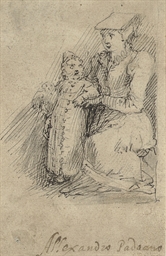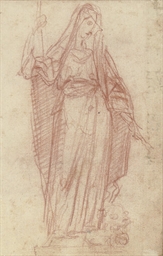Italian School, early 17th Century A dappled grey Neapolitan horse before an extensive landscape oil on canvas 215 x 272cm (84 5/8 x 107 1/16in). Fußnoten As master of horsemanship at the courts of King Charles IX of France, Cardinal Alessandro Farnese and Queen Elizabeth I, Carlo Corte understood well the prestige that good horses and horsemanship could bring to an individual or a family when he wrote: il buon cavallo fa molto istimare un gentil'huomo, che cavalchi bene, et, che abbia buon cavallo; mostrando, che habbia ancora buon giudizio in saperlo eleggere, et mantenere cosi buono, et spender honoratamente le sue facultà in cosa utile, et necessaria, et assai honorevole By the time he had published his Il Cavallerizzo in 1573, horses and horsemanship had become of great importance at the various courts of Italy, none more so than at that of the Gonzaga in Mantua. Federico II Gonzaga registered his gratitude to his steed for saving his life at the battle of Fornovo against the French in 1495 by commissioning a fresco showing him on his knees next to his horse. This marks perhaps the first equine portrait at the court, a subject that was to reach its peak with the celebrated cycle of frescoes in the Sala dei Cavalli at the Palazzo Te. Reserved for grand receptions, the largest room in the palace was dedicated to Francesco II's favourite horses, each depicted in fresco with an identifying inscription below. The project was carried out by Giulio Romano between 1526 and 1528 with the help of Rinaldo Mantovano and Benedetto Pagni Ten years later, the artist also went on to decorate a room in the new Palazzo Reale in Mantua, again with portraits of Francesco's horses but this time they were nine large canvases. These were last recorded in situ in an inventory of 1714 but nothing further is known of them. Two drawings at the National Museum Stockholm (cat. nos. 415 and 466, see fig. 1) were tentatively identified as studies for these paintings. The passion for equine portraiture at the court of the Gonzaga continued well into the 17th century with two works recorded amongst the property of Carlo II Gonzaga Nevers in 1665, one of a horse named il Re d'Ongaria and the other Baio Galante (see R. Piccinelli, Collezionismo a Corte. I Gonzaga Nevers e la superbissima galeria di Mantova (1637-1709), Florence 2012, p. 315). It was not just the Gonzaga who celebrated their horses in this fashion. In his Felsina Pittrice, Malvasia recounts the story of the horse Belladonna, said to have been a gift from the Emperor Ferdinand II to Pope Gregory XV, who was eventually bought by Filippo Maria Aldovrandi simply for her beauty and despite the fact that she had become ill so was of no further use to the Pope (see C. C. Malvasia, Felsina Pittrice: vite de pittori bolognesi, Bologna, 1678, p. 368). Aldovrandi commissioned Guercino to paint her portrait in April of 1631 which was duly noted by Guercino's brother in his Libro dei Conti and it may well be the Cavallo listed in the property of Conte Ercole Maria Aldrovandi in 1672. Equine portraits clearly still enjoyed great popularity throughout the 17th and 18th centuries: numerous works are listed in the inventories of the powerful Italian families. Andrea Cammassei is recorded as having painted three anonymous portraits for the Barberini, for example, and Agostino Masucci is known to have made a cavallo barbaro for the horse-loving Camillo Rospigliosi. The latter also commissioned Giovanni Reder to paint groups of horses that he kept at his tenuta Rospigliosi at Zagarolo (see S. Rudoph, La pittura del '700, Rome, 1983, ill. pl. 607). The present work continues the tradition of equine portraiture established by the Gonzaga in the 16th century with the horse depicted, full-size, in profile and with its head turned slightly towards the viewer. The breed shown is most probably a dappled grey Neapolitan horse (see fig. 2) which was noted at the time for its quality. Corte wrote how highly regarded th
Italian School, early 17th Century A dappled grey Neapolitan horse before an extensive landscape oil on canvas 215 x 272cm (84 5/8 x 107 1/16in). Fußnoten As master of horsemanship at the courts of King Charles IX of France, Cardinal Alessandro Farnese and Queen Elizabeth I, Carlo Corte understood well the prestige that good horses and horsemanship could bring to an individual or a family when he wrote: il buon cavallo fa molto istimare un gentil'huomo, che cavalchi bene, et, che abbia buon cavallo; mostrando, che habbia ancora buon giudizio in saperlo eleggere, et mantenere cosi buono, et spender honoratamente le sue facultà in cosa utile, et necessaria, et assai honorevole By the time he had published his Il Cavallerizzo in 1573, horses and horsemanship had become of great importance at the various courts of Italy, none more so than at that of the Gonzaga in Mantua. Federico II Gonzaga registered his gratitude to his steed for saving his life at the battle of Fornovo against the French in 1495 by commissioning a fresco showing him on his knees next to his horse. This marks perhaps the first equine portrait at the court, a subject that was to reach its peak with the celebrated cycle of frescoes in the Sala dei Cavalli at the Palazzo Te. Reserved for grand receptions, the largest room in the palace was dedicated to Francesco II's favourite horses, each depicted in fresco with an identifying inscription below. The project was carried out by Giulio Romano between 1526 and 1528 with the help of Rinaldo Mantovano and Benedetto Pagni Ten years later, the artist also went on to decorate a room in the new Palazzo Reale in Mantua, again with portraits of Francesco's horses but this time they were nine large canvases. These were last recorded in situ in an inventory of 1714 but nothing further is known of them. Two drawings at the National Museum Stockholm (cat. nos. 415 and 466, see fig. 1) were tentatively identified as studies for these paintings. The passion for equine portraiture at the court of the Gonzaga continued well into the 17th century with two works recorded amongst the property of Carlo II Gonzaga Nevers in 1665, one of a horse named il Re d'Ongaria and the other Baio Galante (see R. Piccinelli, Collezionismo a Corte. I Gonzaga Nevers e la superbissima galeria di Mantova (1637-1709), Florence 2012, p. 315). It was not just the Gonzaga who celebrated their horses in this fashion. In his Felsina Pittrice, Malvasia recounts the story of the horse Belladonna, said to have been a gift from the Emperor Ferdinand II to Pope Gregory XV, who was eventually bought by Filippo Maria Aldovrandi simply for her beauty and despite the fact that she had become ill so was of no further use to the Pope (see C. C. Malvasia, Felsina Pittrice: vite de pittori bolognesi, Bologna, 1678, p. 368). Aldovrandi commissioned Guercino to paint her portrait in April of 1631 which was duly noted by Guercino's brother in his Libro dei Conti and it may well be the Cavallo listed in the property of Conte Ercole Maria Aldrovandi in 1672. Equine portraits clearly still enjoyed great popularity throughout the 17th and 18th centuries: numerous works are listed in the inventories of the powerful Italian families. Andrea Cammassei is recorded as having painted three anonymous portraits for the Barberini, for example, and Agostino Masucci is known to have made a cavallo barbaro for the horse-loving Camillo Rospigliosi. The latter also commissioned Giovanni Reder to paint groups of horses that he kept at his tenuta Rospigliosi at Zagarolo (see S. Rudoph, La pittura del '700, Rome, 1983, ill. pl. 607). The present work continues the tradition of equine portraiture established by the Gonzaga in the 16th century with the horse depicted, full-size, in profile and with its head turned slightly towards the viewer. The breed shown is most probably a dappled grey Neapolitan horse (see fig. 2) which was noted at the time for its quality. Corte wrote how highly regarded th















Try LotSearch and its premium features for 7 days - without any costs!
Be notified automatically about new items in upcoming auctions.
Create an alert